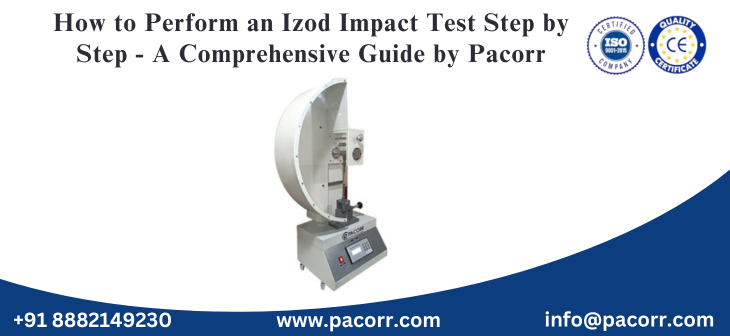
Pacorr stands as a leading name in the world of material testing solutions, renowned for manufacturing advanced testing instruments that ensure the highest quality standards across various industries. One of the essential products in Pacorr’s portfolio is the Izod impact tester, a specialized instrument designed to evaluate the impact resistance and toughness of materials, particularly plastics and metals. Understanding how to perform an Izod Impact Test step by step is vital for ensuring the reliability and durability of products in applications where sudden impacts or shocks are likely.
What is the Izod Impact Test?
The Izod Impact Test is a standardized method for measuring a material’s ability to withstand sudden impact or shock. The test assesses the amount of energy absorbed by a specimen when struck by a swinging pendulum. This value is crucial for understanding how materials behave under sudden loading conditions, making it indispensable for industries such as automotive, aerospace, packaging, and construction.
Izod Impact Tester vs Charpy Impact Tester
While the Izod impact tester is designed for testing specimens in a vertical orientation with a notched edge facing the striking pendulum, the charpy impact tester uses a horizontal specimen setup with the notch facing away from the pendulum. Both testers are critical for assessing material toughness but have specific applications based on industry requirements.
Step-by-Step Guide: How to Perform an Izod Impact Test
Step 1: Prepare the Test Specimens
Proper specimen preparation is the foundation of a reliable Izod Impact Test. Begin by cutting the material into standardized dimensions, typically rectangular bars with precise length, width, and thickness. The most critical feature is the notch, which is machined at a specified location to create a stress concentration point. This notch is essential for ensuring consistent breakage and comparable results.
- Use a high-precision notching cutter to create the notch, ensuring its depth and angle comply with relevant standards such as ASTM D256 or ISO 180.
- Ensure the specimens are free from visible defects, burrs, or inconsistencies that might affect test results.
Step 2: Condition the Specimens
Before testing, specimens must be conditioned to a standard temperature and humidity, usually 23°C and 50% relative humidity, unless otherwise specified. This step ensures repeatability and eliminates environmental variables that could impact material behavior during the test.
- Place specimens in a controlled environment chamber for at least 40 hours.
- Avoid touching the notched area directly to prevent contamination.
Step 3: Set Up the Izod Impact Tester
With the specimens ready, it is time to set up the Izod impact tester. Follow these key steps:
- Ensure the tester is placed on a stable, vibration-free surface.
- Calibrate the device as per the manufacturer’s guidelines, checking the pendulum, clamp, and release mechanisms.
- Verify that the scale or digital readout is set to zero, ensuring accurate energy measurements.
- Select the correct pendulum weight, depending on the material’s expected impact strength.
Step 4: Mount the Test Specimen
- Secure the specimen vertically in the holding fixture, ensuring the notched side faces the direction of the pendulum’s swing.
- Adjust the clamp so the specimen is held firmly but not deformed.
- Double-check the specimen’s orientation and positioning, as this directly affects the accuracy and repeatability of results.
Step 5: Conduct a Safety Check
Safety is paramount when using high-energy testing instruments like the Izod impact tester. Make sure all personnel are clear of the pendulum’s swing path. Wear appropriate personal protective equipment, such as safety goggles and gloves, and confirm that the safety shield is in place.
Step 6: Release the Pendulum
- Raise the pendulum to its starting position, locking it securely as specified in the instrument’s manual.
- Confirm all settings, including the specimen’s alignment and the pendulum’s release mechanism.
- Release the pendulum in a controlled manner. As the pendulum swings down, it strikes the notched specimen, breaking it.
Step 7: Record the Test Results
- Observe the pointer or digital display, which shows the amount of energy absorbed by the specimen during fracture.
- Record the value in Joules or foot-pounds, depending on the test standard.
- Note any irregularities in fracture patterns or unexpected breaks, as these may indicate specimen preparation issues or material defects.
Step 8: Analyze and Interpret Results
After completing multiple tests (typically at least five specimens per material batch), calculate the average absorbed energy. Compare these values against industry benchmarks, quality standards, or historical data to assess material toughness.
- Consider factors like fracture appearance, consistency, and outliers in your analysis.
- If necessary, repeat the test or adjust specimen preparation to resolve inconsistencies.
Tips for Accurate Izod Impact Testing
- Always use calibrated equipment and verify calibration regularly for both Izod impact tester and charpy impact tester.
- Store and handle specimens carefully to avoid micro-cracks or contamination that can skew results.
- Document each test, including specimen details, environmental conditions, and operator information for traceability.
When to Use Charpy Impact Tester Instead
While this guide focuses on how to perform an Izod Impact Test step by step, many labs also utilize the charpy impact tester for similar purposes, especially when different material orientations or notching requirements are needed. Understanding both methods ensures comprehensive material toughness evaluation.
Applications of the Izod Impact Test Across Industries
Automotive Sector
Manufacturers use the Izod impact tester to assess the safety and reliability of plastic components in vehicles. Impact-resistant bumpers, dashboards, and protective trims are subjected to this test to meet strict safety standards.
Plastic and Polymer Industry
Material scientists rely on the Izod Impact Test to select suitable polymers for packaging, consumer goods, and industrial products. By understanding impact resistance, they ensure that materials will not fail under real-world conditions.
Construction and Building Materials
Building material suppliers test pipes, panels, and structural plastics with an Izod impact tester to guarantee long-term durability and safety.
Electronics and Appliances
Electronics manufacturers evaluate casings and components to confirm they can withstand accidental drops or impacts, improving product safety and customer satisfaction.
Key Advantages of Using Pacorr’s Izod Impact Tester
- High precision and repeatability
- User-friendly interface and robust build quality
- Compatibility with both national and international testing standards
- Reliable after-sales support and expert technical guidance
Frequently Asked Questions (FAQs) About Izod Impact Test
Q1: What is the difference between Izod impact tester and Charpy impact tester?
A: The main difference lies in specimen orientation and the direction of the applied force. The Izod impact tester holds specimens vertically with the notch facing the pendulum, while the charpy impact tester uses a horizontal orientation with the notch facing away. Both measure material toughness but are suited to different applications.
Q2: Why is specimen notching important in the Izod Impact Test?
A: The notch creates a controlled weak point, ensuring the specimen breaks consistently and enabling accurate energy measurement.
Q3: How often should the Izod impact tester be calibrated?
A: Calibration should be performed as per manufacturer recommendations or industry standards, typically before major testing batches and after significant instrument use.
Q4: Can the Izod Impact Test be used for metals and non-plastics?
A: Yes, the test is widely used for metals, composites, and other non-plastic materials, but the specimen size and notch configuration may vary according to material type.
Q5: How do environmental conditions affect Izod Impact Test results?
A: Temperature and humidity can significantly influence material behavior. Consistent conditioning of specimens ensures accurate and reliable test outcomes.
Conclusion: Why Choose Pacorr for Your Impact Testing Needs
Understanding how to perform an Izod Impact Test step by step is crucial for any organization committed to quality and material performance. Pacorr, with its advanced Izod impact tester and expertise in material testing solutions, ensures that your laboratory or production unit meets the highest standards of accuracy, efficiency, and reliability.
By following this comprehensive guide, professionals and quality control managers can confidently perform Izod Impact Testing, interpret results accurately, and make data-driven decisions to enhance product quality. For advanced material testing solutions, technical support, or more information about the Izod impact tester and charpy impact tester, trust Pacorr – your partner in quality and innovation.
Thanks to Pacorr Testing instruments, we have all the required quality testing instruments that have helped us to ensure the best quality delivered to our clients.

Danish
Fair Exports Pvt. Ltd.

